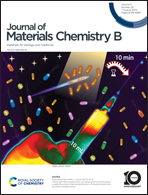A biocompatible polyethylene glycol/alginate composite hydrogel with significant reactive oxygen species consumption for promoting wound healing†
Abstract
In areas of wound inflammation, excessive reactive oxygen species (ROS) may worsen the infection and lead to tissue damage, resulting in a vicious circle. Therefore, many hydrogels with sensitive ROS consumption capabilities and antibacterial properties have been widely developed and applied. These hydrogels usually achieve their ROS consumption capacity by introducing reactive active groups: however, these materials normally require complicated preparation procedures and have high potential toxicity. Inspired by these limitations, an integrated polyethylene glycol/alginate-based hydrogel (itg-PEGDA@SA) has been developed via a simple two-step process, where the inner PEGDA hydrogel (hdg-PEGDA) acts as a ROS scavenger and the outer sodium alginate hydrogel (SA) can be degraded to act as a recombinant human epidermal growth factor (rhEGF)-loaded platform to enhance the functionality of this composite hydrogel. Altogether, the itg-PEGDA@SA hydrogel showed significant ROS consumption and biocompatibility in vitro, and when applied for wound healing, the formation of uniform and ordered collagen fibers (stained using aniline blue) can be achieved. This hydrogel showed favorable attributes in ROS scavenging, and it can be a promising material for use in wound dressings and biomaterial fields.



 Please wait while we load your content...
Please wait while we load your content...